The Response of Alpine Permafrost to Decadal Human Disturbance in the Context of Climate Warming
Highlights
- Permafrost in the Muri area responded to human disturbance without significant spatial expansion during 2000–2024.
- The semi-arid climate, rough terrain, thin root zone and gappy vertical structure underneath were the major factors.
- Annual ALT estimated from 2000 to 2024 filled the data gap of high-resolution ALT in the Muri area.
- Knowledge was provided for a better understanding of alpine permafrost development.
Abstract
1. Introduction
2. Materials and Methods
2.1. Study Area
2.2. Data
2.2.1. MODIS LST and Normalized Difference in Vegetation Index (NDVI)
2.2.2. Landsat
2.2.3. DEMs
2.2.4. In Situ Data
2.3. Method
2.3.1. Preprocessing MODIS and Landsat Data
2.3.2. Downscaling MODIS NDVI and LST
2.3.3. Deriving ALT
2.3.4. Determining ALT-DDT Coefficient
3. Results
3.1. Quality of Downscaling Models
3.2. Comparison of Landsat LST, MODIS LST and Downscaled LST
3.3. ALT-DDT Coefficient and Quality of the Estimated ALT
3.3.1. ALT-DDT Coefficient
3.3.2. Accuracy of the Estimated ALT
3.4. Comparison of the ALT Estimated from MODIS LST and the Downscaled LST
3.4.1. Spatial Distribution of ALT in Typical Years
3.4.2. Temporal Changes in NDVI, LST and ALT Along Typical Profiles
3.5. Multi-Year and Seasonal Changes in ALT and LST at Typical Site
4. Discussion
4.1. Reliability of ALT Estimated from the Downscaled LST
4.2. Driving Forces of Alpine Permafrost Variations
4.3. Significance of Study
5. Conclusions and Outlook
Supplementary Materials
Author Contributions
Funding
Data Availability Statement
Acknowledgments
Conflicts of Interest
References
- Iwata, H.; Harazono, Y.; Ueyama, M. The Role of Permafrost in Water Exchange of a Black Spruce Forest in Interior Alaska. Agric. For. Meteorol. 2012, 161, 107–115. [Google Scholar] [CrossRef]
- Gao, Z.; Niu, F.; Lin, Z. Effects of Permafrost Degradation on Thermokarst Lake Hydrochemistry in the Qinghai-Tibet Plateau, China. Hydrol. Process. 2020, 34, 5659–5673. [Google Scholar] [CrossRef]
- Sjöberg, Y.; Jan, A.; Painter, S.L.; Coon, E.T.; Carey, M.P.; O’Donnell, J.A.; Koch, J.C. Permafrost Promotes Shallow Groundwater Flow and Warmer Headwater Streams. Water Resour. Res. 2020, 57, e2020WR027463. [Google Scholar] [CrossRef]
- Jin, X.; Jin, H.; Luo, D.; Sheng, Y.; Wu, Q.; Wu, J.; Wang, W.; Huang, S.; Li, X.; Liang, S.; et al. Impacts of Permafrost Degradation on Hydrology and Vegetation in the Source Area of the Yellow River on Northeastern Qinghai-Tibet Plateau, Southwest China. Front. Earth Sci. 2022, 10, 845824. [Google Scholar] [CrossRef]
- Wang, G.; Li, Y.; Wang, Y.; Wu, Q. Effects of Permafrost Thawing on Vegetation and Soil Carbon Pool Losses on the Qinghai-Tibet Plateau, China. Geoderma 2008, 143, 143–152. [Google Scholar] [CrossRef]
- Chen, X.; Jeong, S. Asymmetric Impacts of Surface Thaw Onset Change on Seasonal Vegetation Growth in Arctic Permafrost. Glob. Ecol. Biogeogr. 2024, 33, 131–140. [Google Scholar] [CrossRef]
- Jin, X.Y.; Jin, H.J.; Iwahana, G.; Marchenko, S.S.; Luo, D.L.; Li, X.Y.; Liang, S.H. Impacts of Climate-Induced Permafrost Degradation on Vegetation: A Review. Adv. Clim. Change Res. 2021, 12, 29–47. [Google Scholar] [CrossRef]
- Biskaborn, B.K.; Smith, S.L.; Noetzli, J.; Matthes, H.; Vieira, G.; Streletskiy, D.A.; Schoeneich, P.; Romanovsky, V.E.; Lewkowicz, A.G.; Abramov, A.; et al. Permafrost Is Warming at a Global Scale. Nat. Commun. 2019, 10, 264. [Google Scholar] [CrossRef]
- Smith, S.L.; O’Neill, H.B.; Isaksen, K.; Noetzli, J.; Romanovsky, V.E. The Changing Thermal State of Permafrost. Nat. Rev. Earth Environ. 2022, 3, 10–23. [Google Scholar] [CrossRef]
- Luo, D.; Jin, H.; Bense, V.F.; Jin, X.; Li, X. Hydrothermal Processes of Near-Surface Warm Permafrost in Response to Strong Precipitation Events in the Headwater Area of the Yellow River, Tibetan Plateau. Geoderma 2020, 376, 114531. [Google Scholar] [CrossRef]
- Peng, X.; Zhang, T.; Frauenfeld, O.W.; Wang, K.; Cao, B.; Zhong, X.; Su, H.; Mu, C. Response of Seasonal Soil Freeze Depth to Climate Change across China. Cryosphere 2017, 11, 1059–1073. [Google Scholar] [CrossRef]
- Turetsky, M.R.; Jones, M.C.; Walter Anthony, K.; Olefeldt, D.; Schuur, E.A.G.; Koven, C.; Mcguire, A.D.; Grosse, G. Permafrost Collapse Is Accelerating Carbon Release. Nature 2019, 569, 32–34. [Google Scholar] [CrossRef] [PubMed]
- Dobiński, W. Permafrost Active Layer. Earth Sci. Rev. 2020, 208, 103301. [Google Scholar] [CrossRef]
- Wu, Q.; Zhang, T. Changes in Active Layer Thickness over the Qinghai-Tibetan Plateau from 1995 to 2007. J. Geophys. Res. Atmos. 2010, 115, D09107. [Google Scholar] [CrossRef]
- Ran, Y.; Li, X.; Cheng, G.; Nan, Z.; Che, J.; Sheng, Y.; Wu, Q.; Jin, H.; Luo, D.; Tang, Z.; et al. Mapping the Permafrost Stability on the Tibetan Plateau for 2005–2015. Sci. China Earth Sci. 2021, 64, 62–79. [Google Scholar] [CrossRef]
- Yang, M.; Nelson, F.E.; Shiklomanov, N.I.; Guo, D.; Wan, G. Permafrost Degradation and Its Environmental Effects on the Tibetan Plateau: A Review of Recent Research. Earth Sci. Rev. 2010, 103, 31–44. [Google Scholar] [CrossRef]
- Wu, Q.; Hou, Y.; Yun, H.; Liu, Y. Changes in Active-Layer Thickness and near-Surface Permafrost between 2002 and 2012 in Alpine Ecosystems, Qinghai-Xizang (Tibet) Plateau, China. Glob. Planet. Change 2015, 124, 149–155. [Google Scholar] [CrossRef]
- Xu, X.; Wu, Q. Active Layer Thickness Variation on the Qinghai-Tibetan Plateau Historical and Projected Trends. J. Geophys. Res. Atmos. 2021, 126, e2021JD034841. [Google Scholar] [CrossRef]
- Li, C.; Wei, Y.; Liu, Y.; Li, L.; Peng, L.; Chen, J.; Liu, L.; Dou, T.; Wu, X. Active Layer Thickness in the Northern Hemisphere: Changes from 2000 to 2018 and Future Simulations. J. Geophys. Res. Atmos. 2022, 127, e2022JD036785. [Google Scholar] [CrossRef]
- Pang, Q.; Cheng, G.; Li, S.; Zhang, W. Active Layer Thickness Calculation over the Qinghai-Tibet Plateau. Cold Reg. Sci. Technol. 2009, 57, 23–28. [Google Scholar] [CrossRef]
- Qin, Y.; Wu, T.; Zhao, L.; Wu, X.; Li, R.; Xie, C.; Pang, Q.; Hu, G.; Qiao, Y.; Zhao, G.; et al. Numerical Modeling of the Active Layer Thickness and Permafrost Thermal State Across Qinghai-Tibetan Plateau. J. Geophys. Res. Atmos. 2017, 122, 604–611. [Google Scholar] [CrossRef]
- Zheng, G.; Yang, Y.; Yang, D.; Dafflon, B.; Yi, Y.; Zhang, S.; Chen, D.; Gao, B.; Wang, T.; Shi, R.; et al. Remote Sensing Spatiotemporal Patterns of Frozen Soil and the Environmental Controls over the Tibetan Plateau during 2002–2016. Remote Sens. Environ. 2020, 247, 111927. [Google Scholar] [CrossRef]
- Zhang, C.; Douglas, T.A.; Anderson, J.E. Modeling and Mapping Permafrost Active Layer Thickness Using Field Measurements and Remote Sensing Techniques. Int. J. Appl. Earth Obs. Geoinf. 2021, 102, 102455. [Google Scholar] [CrossRef]
- Gangodagamage, C.; Rowland, J.C.; Hubbard, S.S.; Brumby, S.P.; Liljedahl, A.K.; Wainwright, H.; Wilson, C.J.; Altmann, G.L.; Dafflon, B.; Peterson, J.; et al. Extrapolating Active Layer Thickness Measurements across Arctic Polygonal Terrain Using LiDAR and NDVI Data Sets. Water Resour. Res. 2014, 50, 6339–6357. [Google Scholar] [CrossRef] [PubMed]
- Wang, G.; Niu, S.; Yan, D.; Liang, S.; Su, Y.; Wang, W.; Yin, T.; Sun, X.; Wan, L. Simulation of Active Layer Thickness Based on Multi-Source Remote Sensing Data and Integrated Machine Learning Models: A Case Study of the Qinghai-Tibet Plateau. Remote Sens. 2025, 17, 2006. [Google Scholar] [CrossRef]
- Shen, T.; Jiang, P.; Ju, Q.; Yu, Z.; Chen, X.; Lin, H.; Zhang, Y. Changes in Permafrost Spatial Distribution and Active Layer Thickness from 1980 to 2020 on the Tibet Plateau. Sci. Total Environ. 2023, 859, 160381. [Google Scholar] [CrossRef]
- Peng, J.; Loew, A.; Merlin, O.; Verhoest, N.E.C. A Review of Spatial Downscaling of Satellite Remotely Sensed Soil Moisture. Rev. Geophys. 2017, 55, 341–366. [Google Scholar] [CrossRef]
- Xu, S.; Wu, C.; Wang, L.; Gonsamo, A.; Shen, Y.; Niu, Z. A New Satellite-Based Monthly Precipitation Downscaling Algorithm with Non-Stationary Relationship between Precipitation and Land Surface Characteristics. Remote Sens. Environ. 2015, 162, 119–140. [Google Scholar] [CrossRef]
- Wang, F.; Tian, D.; Lowe, L.; Kalin, L.; Lehrter, J. Deep Learning for Daily Precipitation and Temperature Downscaling. Water Resour. Res. 2021, 57, e2020WR029308. [Google Scholar] [CrossRef]
- Zhao, W.; Sánchez, N.; Lu, H.; Li, A. A Spatial Downscaling Approach for the SMAP Passive Surface Soil Moisture Product Using Random Forest Regression. J. Hydrol. 2018, 563, 1009–1024. [Google Scholar] [CrossRef]
- Srivastava, P.K.; Han, D.; Ramirez, M.R.; Islam, T. Machine Learning Techniques for Downscaling SMOS Satellite Soil Moisture Using MODIS Land Surface Temperature for Hydrological Application. Water Resour. Manag. 2013, 27, 3127–3144. [Google Scholar] [CrossRef]
- Wan, Z. Collection-6 MODIS Land Surface Temperature Products Users’ Guide; ERI, University of California: Santa Barbara, CA, USA, 2006. [Google Scholar]
- Sayler, K.; Glynn, T.A. Landsat 8-9 Collection 2(C2) Level 2 Science Product(L2SP) Guide; Department of the Interior U.S. Geological Survey: EROS Sioux Falls, SD, USA, 2022.
- Sayler, K.; Zanter, K. Landsat 4-7 Level 2 Science Product (L2SP) Guide; Department of the Interior U.S. Geological Survey: Sioux Falls, SD, USA, 2021.
- Werner, M. Shuttle Radar Topography Mission (SRTM) Mission Overview. Frequenz 2001, 55, 75–79. [Google Scholar] [CrossRef]
- Ludwig, R.; Schneider, P. Validation of Digital Elevation Models from SRTM X-SAR for Applications in Hydrologic Modeling. ISPRS J. Photogramm. Remote Sens. 2006, 60, 339–358. [Google Scholar] [CrossRef]
- Krieger, G.; Moreira, A.; Fiedler, H.; Hajnsek, I.; Werner, M.; Younis, M.; Zink, M. TanDEM-X: A Satellite Formation for High-Resolution SAR Interferometry. IEEE Trans. Geosci. Remote Sens. 2007, 45, 3317–3341. [Google Scholar] [CrossRef]
- Gonzalez, C.; Luis, J.; Bello, B.; Zink, M. TanDEM-X 30m Edited DEM Product Description; Microwaves and Radar Institute: Oberpfaffenhofen, Germany, 2023. [Google Scholar]
- Wang, Z. Study on the Evolution Mechanism of Regional Groundwater Circulation Under the Condition of Plateau Permafrost Degradation; Chinese Academy of Geological Sciences: Beijing, China, 2020. [Google Scholar]
- Li, J.; Sheng, Y.; Chen, J.; Zhang, B.; Wu, J.; Zhang, X. Characteristics of Ground Temperatures and Influencing Factors of Permafrost Development and Distribution in the Source Region of Datong River. Prog. Geogr. 2011, 30, 827–836. [Google Scholar]
- Zhang, B.; Sheng, Y.; Chen, J.; Li, J. In-Situ Test Study on the Cooling Effect of Two-Phase Closed Thermosyphon in Marshy Permafrost Regions along the Chaidaer-Muli Railway, Qinghai Province, China. Cold Reg. Sci. Technol. 2011, 65, 456–464. [Google Scholar] [CrossRef]
- Liu, X.; Guanter, L.; Liu, L.; Damm, A.; Malenovský, Z.; Rascher, U.; Peng, D.; Du, S.; Gastellu-Etchegorry, J.P. Downscaling of Solar-Induced Chlorophyll Fluorescence from Canopy Level to Photosystem Level Using a Random Forest Model. Remote Sens. Environ. 2018, 231, 110772. [Google Scholar] [CrossRef]
- He, X.; Chaney, N.W.; Schleiss, M.; Sheffield, U. Spatial Downscaling of Precipitation Using Adaptable Random Forests. Water Resour. Res. 2016, 5, 8217–8237. [Google Scholar] [CrossRef]
- Breiman, L. Bagging Predictions. Mach. Learn. 1996, 24, 123–140. [Google Scholar] [CrossRef]
- Breiman, L. Random Forest; University of California Berkeley: Berkeley, CA, USA, 2001. [Google Scholar]
- Luo, Y.; Yang, Y.; Yang, D.; Zhang, S. Quantifying the Impact of Vegetation Changes on Global Terrestrial Runoff Using the Budyko Framework. J. Hydrol. 2020, 590, 125389. [Google Scholar] [CrossRef]
- Nelson, F.E.; Outcalt, S.I. A Computational Method for Prediction and Regionalization of Permafrost. Arct. Alp. Res. 1987, 19, 279–288. [Google Scholar] [CrossRef]
- Peng, X.; Zhang, T.; Frauenfeld, O.W.; Wang, K.; Luo, D.; Cao, B.; Su, H.; Jin, H.; Wu, Q. Spatiotemporal Changes in Active Layer Thickness under Contemporary and Projected Climate in the Northern Hemisphere. J. Clim. 2018, 31, 251–266. [Google Scholar] [CrossRef]
- Frauenfeld, O.W.; Zhang, T. An Observational 71-Year History of Seasonally Frozen Ground Changes in the Eurasian High Latitudes. Environ. Res. Lett. 2011, 6, 044024. [Google Scholar] [CrossRef]
- Peng, X.; Zhang, T.; Cao, B.; Wang, Q.; Wang, K.; Shao, W.; Guo, H. Changes in Freezing-Thawing Index and Soil Freeze Depth over the Heihe River Basin, Western China. Arctic Antarct. Alp. Res. 2016, 48, 161–176. [Google Scholar] [CrossRef]
- Luo, D.; Liua, L.; Jin, H.; Wang, X.; Chen, F. Characteristics of Ground Surface Temperature at Chalaping in the Source Area of the Yellow River, Northeastern Tibetan Plateau. Agric. For. Meteorol. 2020, 281, 107819. [Google Scholar] [CrossRef]
- Heggem, E.S.F.; Etzelmu¨ller, B.; Anarmaa, S.; Sharkhuu, N.; Goulden, C.E.; Nandinsetseg, B. Spatial Distribution of Ground Surface Temperatures and Active Layer Depths in the Hovsgol Area, Northern Mongolia. Permafr. Periglac. Process. 2006, 17, 357–369. [Google Scholar] [CrossRef]
- Fang, X.; Luo, S.; Lyu, S.; Cheng, C.; Li, Z.; Zhang, S. Numerical Modeling of the Responses of Soil Temperature and Soil Moisture to Climate Change over the Tibetan Plateau, 1961–2010. Int. J. Climatol. 2021, 41, 4134–4150. [Google Scholar] [CrossRef]
- Duman, T.; Huang, C.W.; Litvak, M.E. Recent Land Cover Changes in the Southwestern US Lead to an Increase in Surface Temperature. Agric. For. Meteorol. 2021, 297, 108246. [Google Scholar] [CrossRef]
- Feng, Y.; Sihai, L.; Xingxing, K.; Guangjun, W.; Xu-Sheng, W.; Pan, W.; Li, W.; Wu, Q. Effect of Climate and Thaw Depth on Alpine Vegetation Variations at Different Permafrost Degrading Stages in the Tibetan Plateau, China. Arctic Antarct. Alp. Res. 2019, 51, 155–172. [Google Scholar] [CrossRef]
- Luo, D.; Jin, H.; Lü, L.; Zhou, J. Spatiotemporal Changes in Extreme Ground Surface Temperatures and the Relationship with Air Temperatures in the Three-River Source Regions during 1980–2013. Theor. Appl. Climatol. 2016, 123, 885–897. [Google Scholar] [CrossRef]
- You, Y.; Guo, L.; Yu, Q.; Wang, X.; Pan, X.; Wu, Q.; Wang, D.; Wang, G. Spatial Variability and Influential Factors of Active Layer Thickness and Permafrost Temperature Change on the Qinghai-Tibet Plateau from 2012 to 2018. Agric. For. Meteorol. 2022, 318, 108913. [Google Scholar] [CrossRef]
- Shen, T.; Jiang, P.; Ju, Q.; Zhao, J.; Chen, X.; Lin, H.; Yang, B.; Tan, C.; Zhang, Y.; Fu, X.; et al. Permafrost on the Tibetan Plateau Is Degrading: Historical and Projected Trends. J. Hydrol. 2024, 628, 130501. [Google Scholar] [CrossRef]
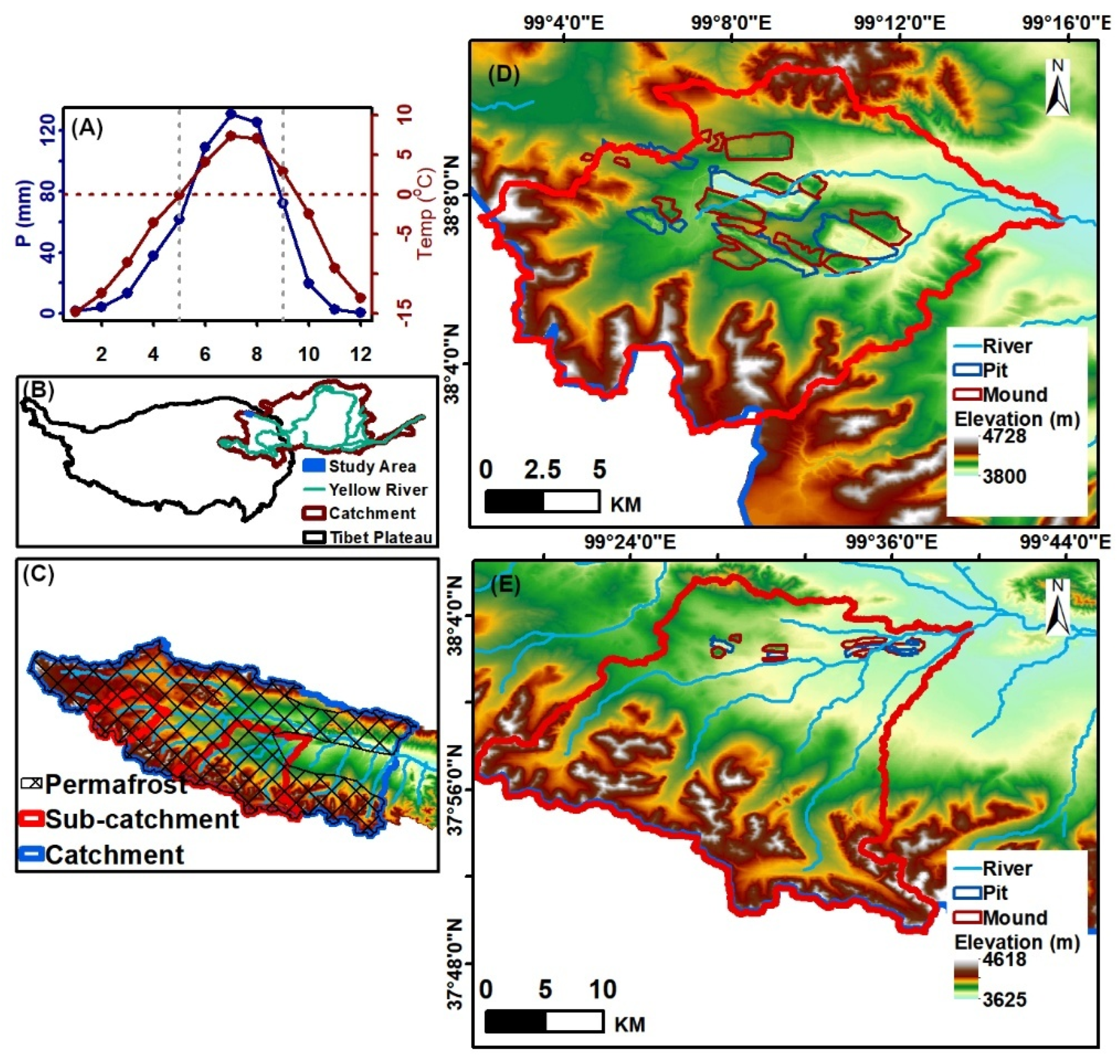
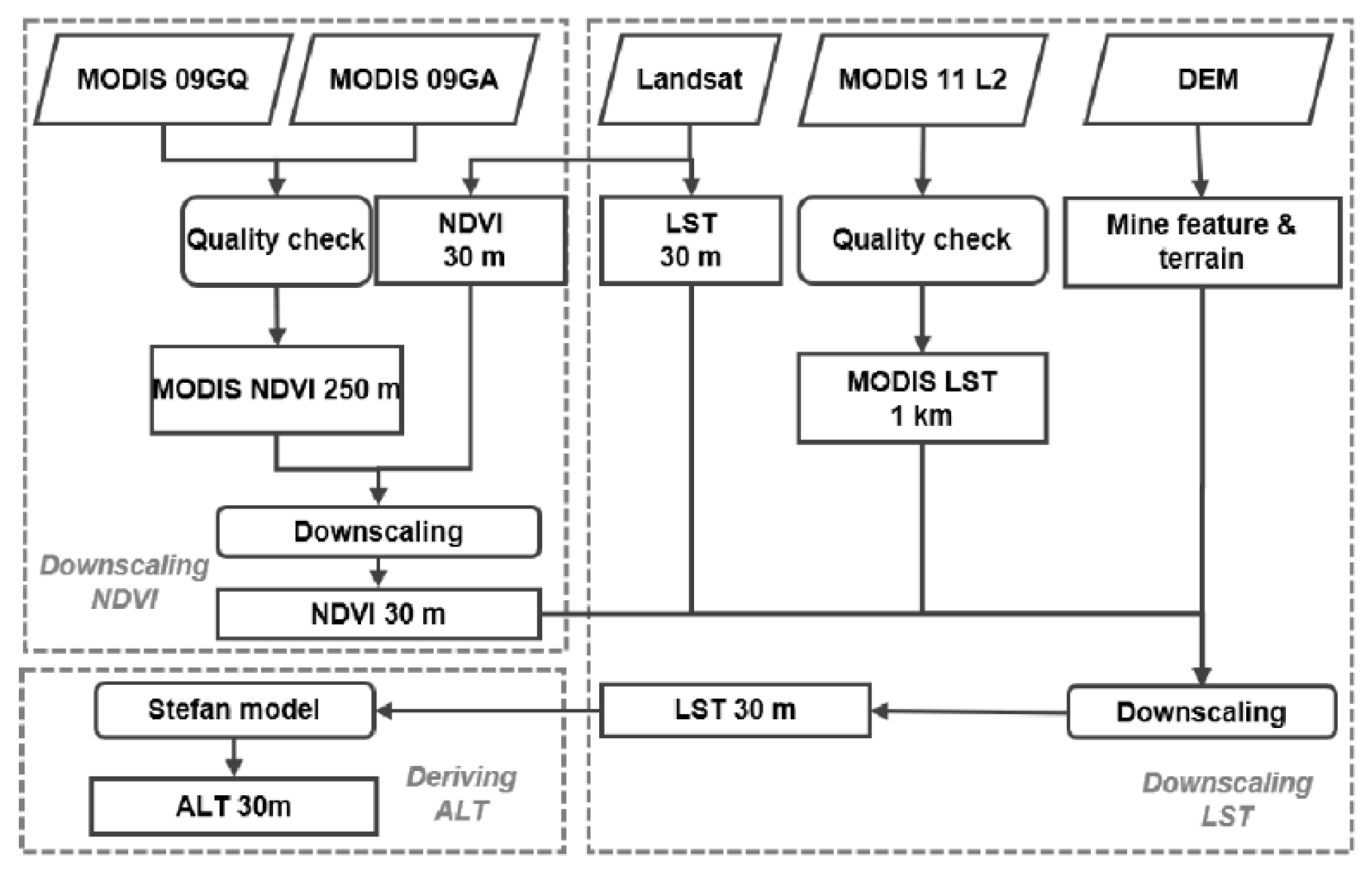
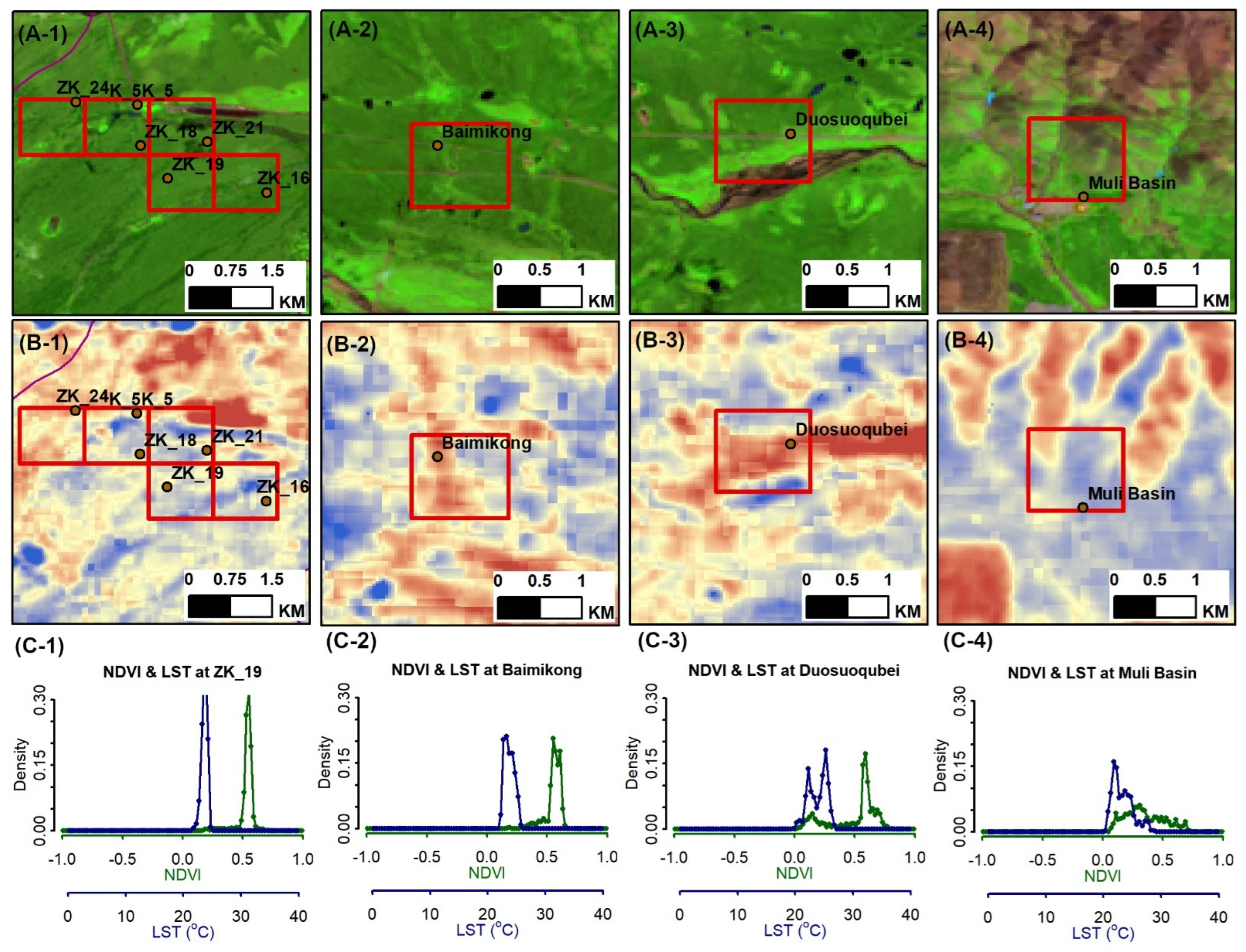
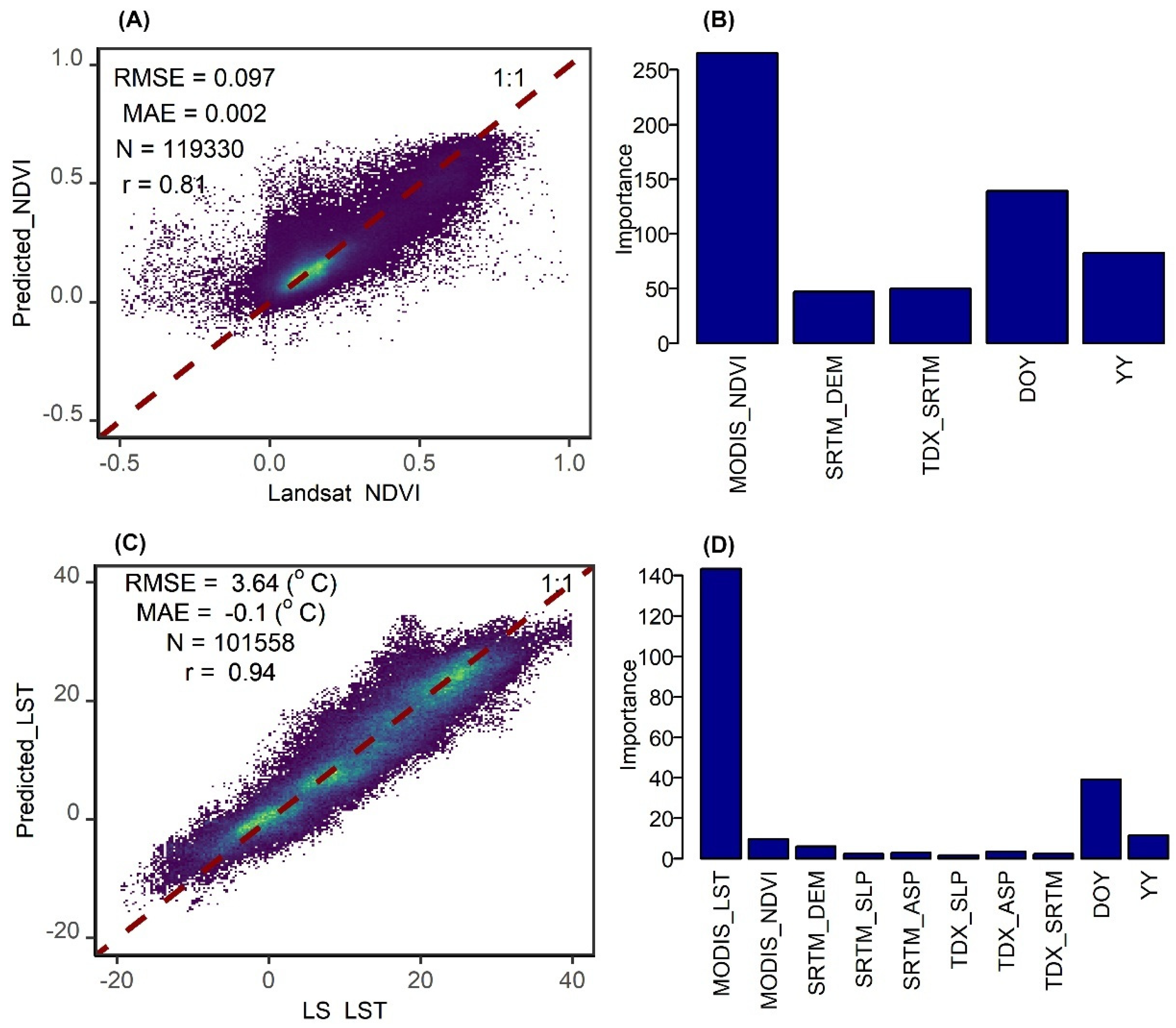
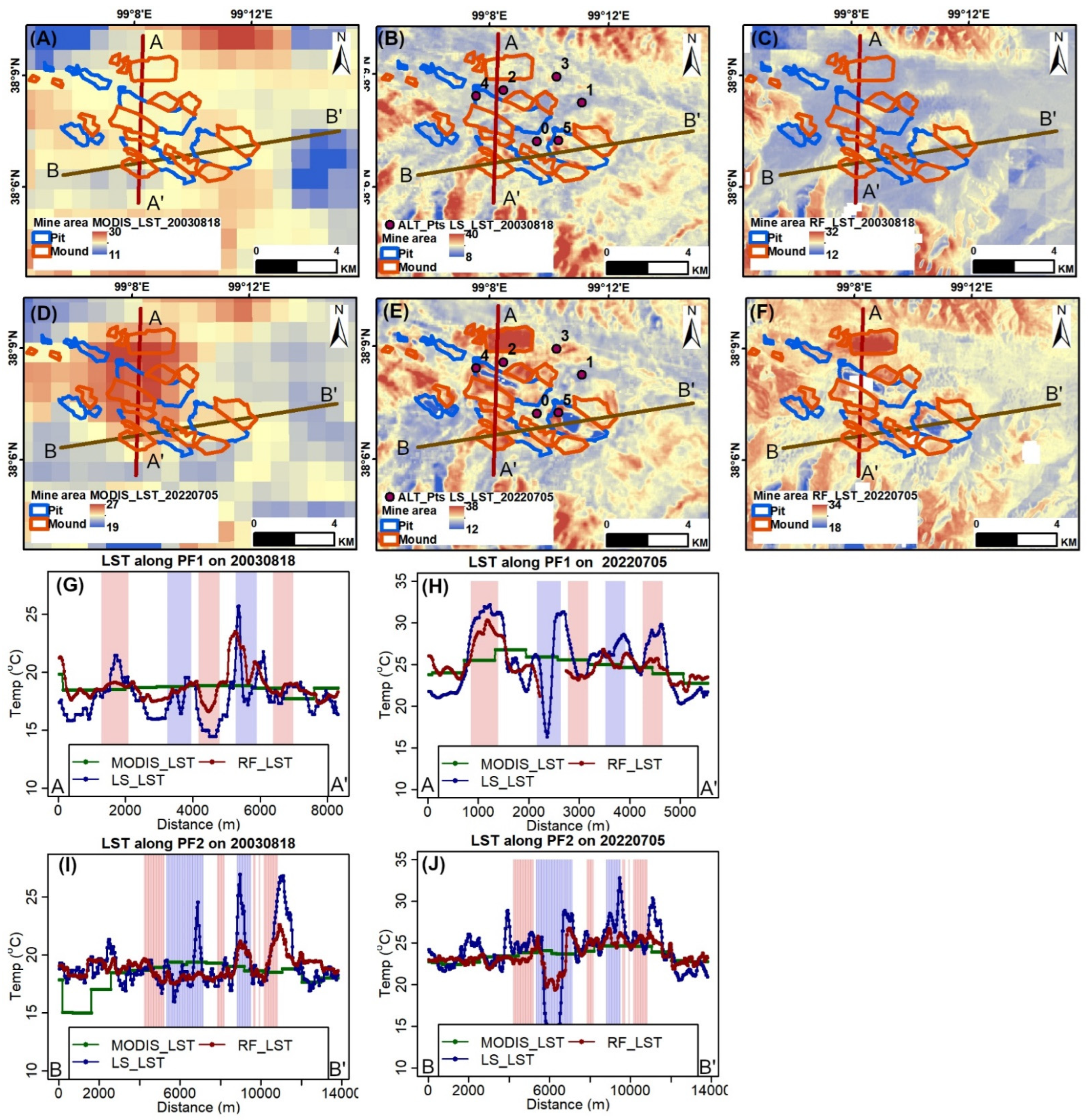
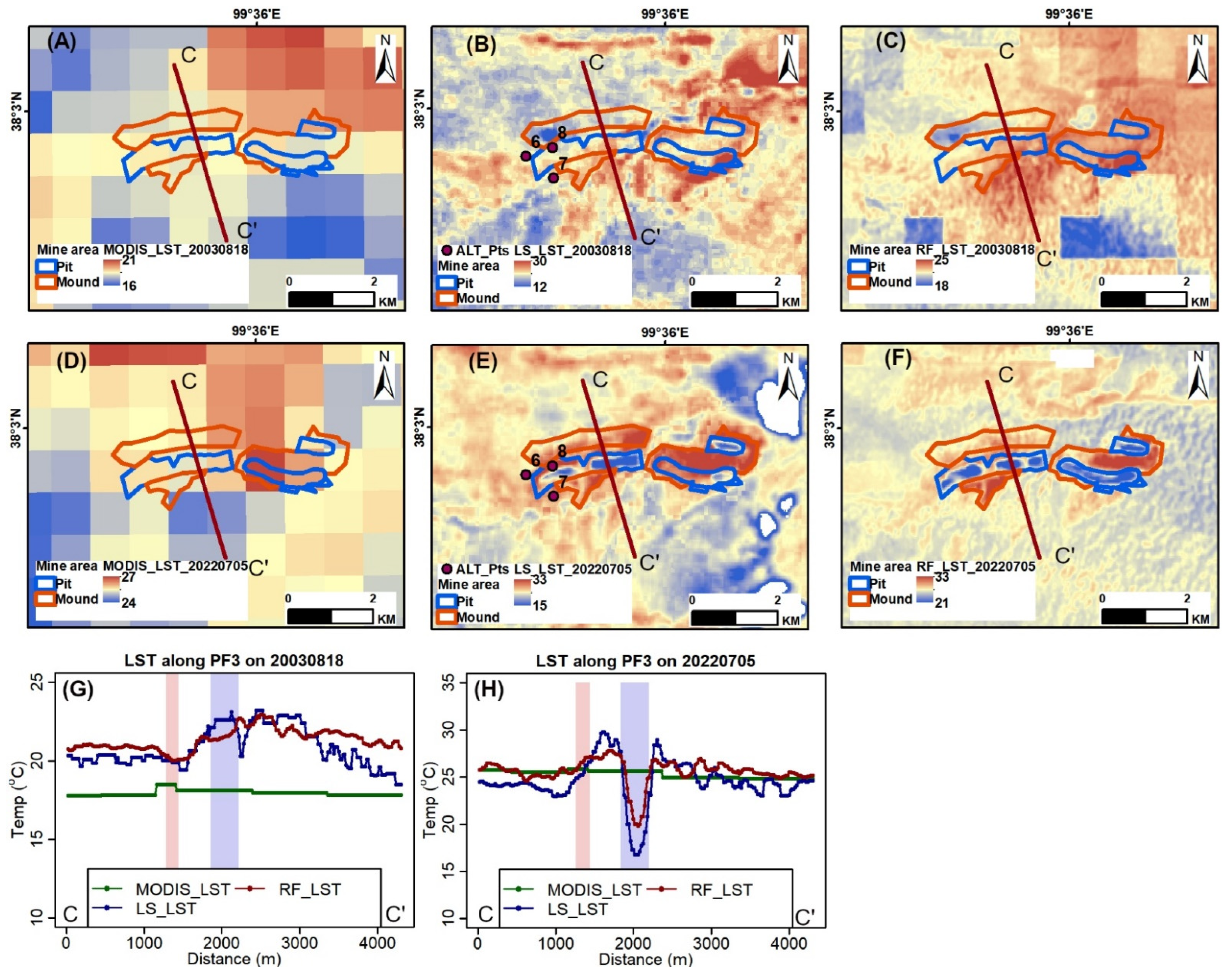

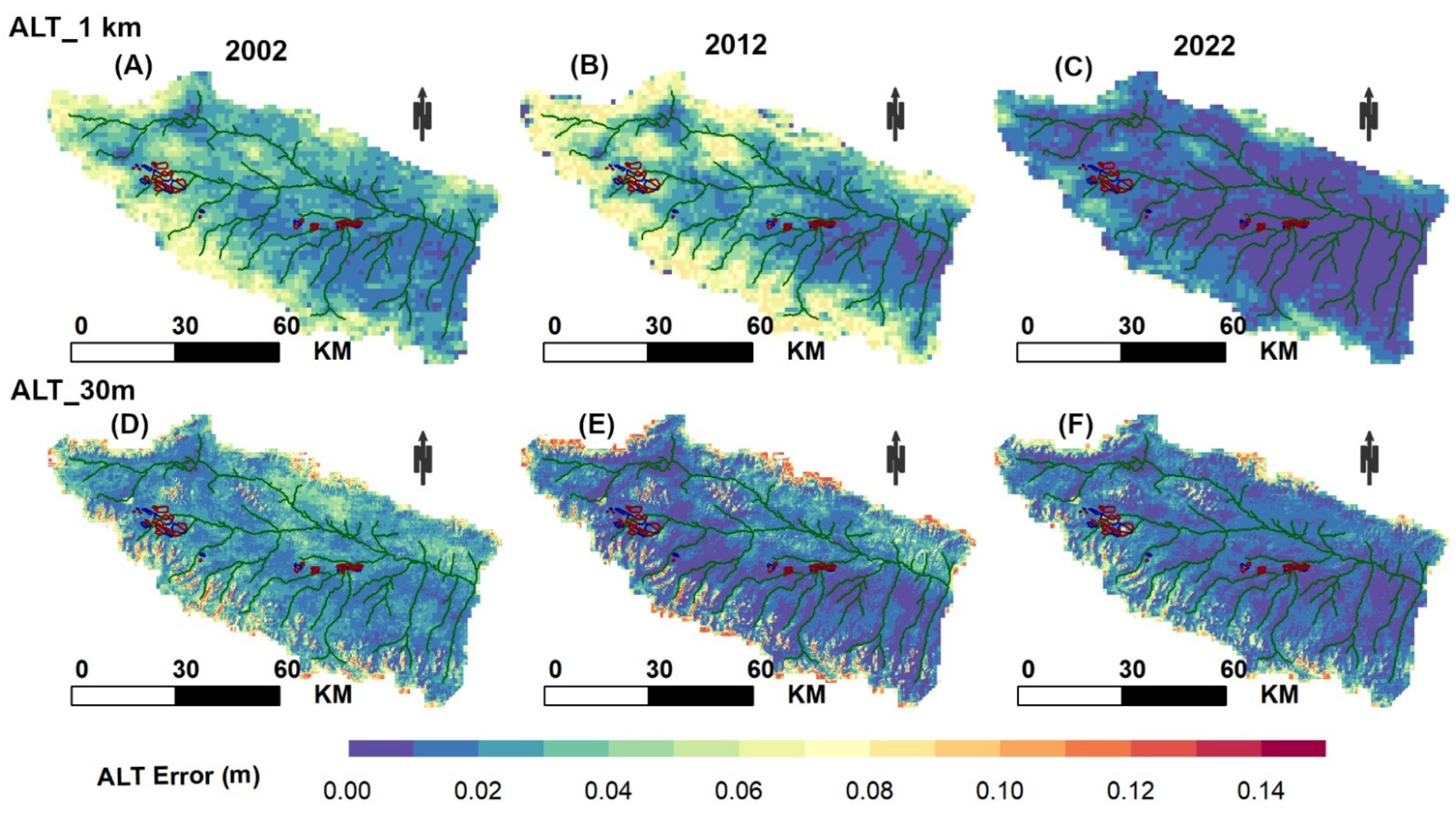

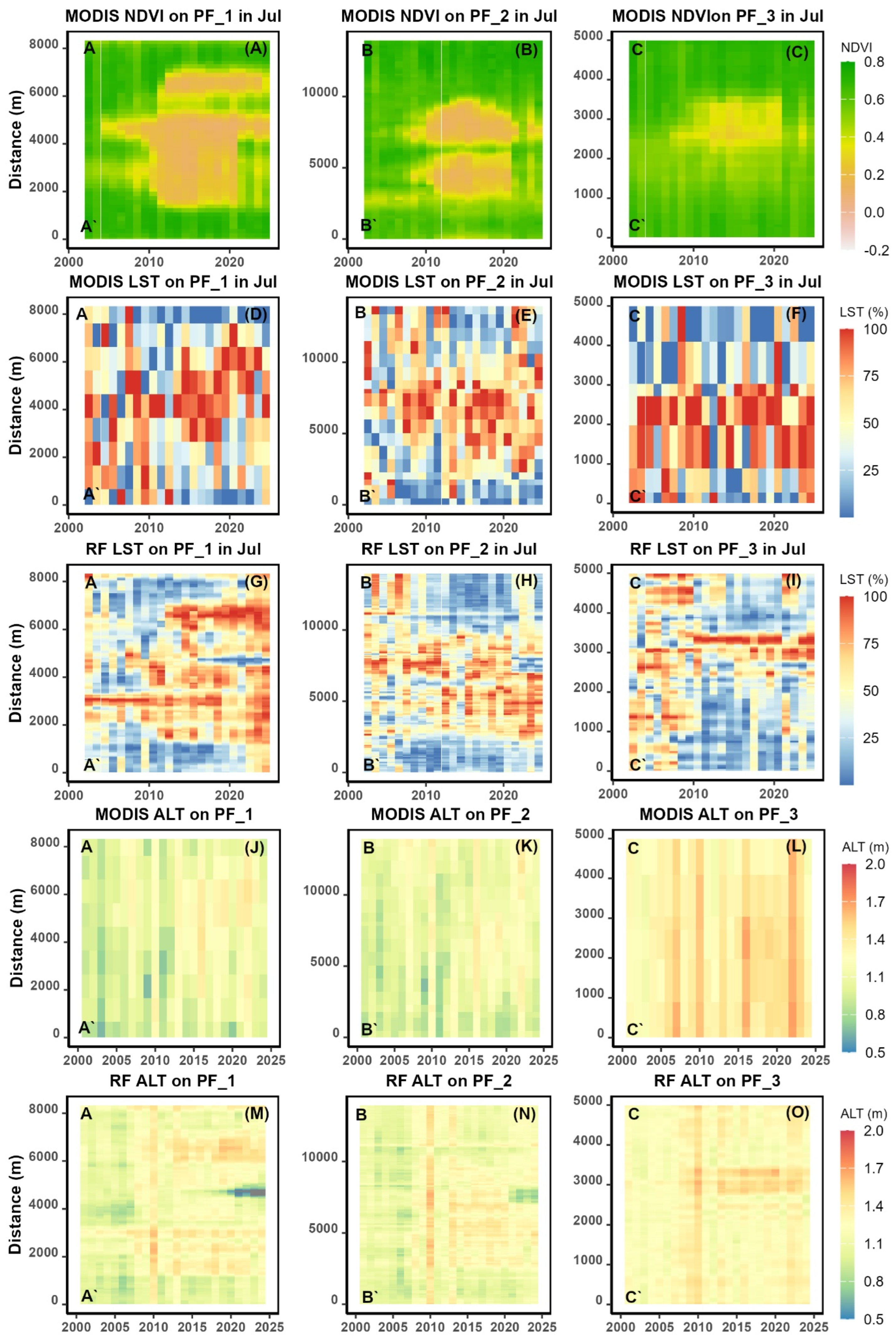

| Borehole ID | Lon | Lat | Year | ALT (m) | NDVI * | LST * | DDT 30 m (°C) | DDT 1 km (°C) | ||||
|---|---|---|---|---|---|---|---|---|---|---|---|---|
| Mean | SD | Mean | SD | |||||||||
| Baimikong | 99.26203 | 38.14037 | 2010 | 1.2 | 0.56 | 0.06 | 23.73 | 0.81 | 1728 | 1225 | 0.029 | 0.034 |
| Sainuoranghe | 99.46584 | 38.10309 | 2009 | 1.2 | 0.61 | 0.11 | 24.29 | 1.26 | 1248 | 783 | 0.034 | 0.043 |
| ZK_8 | 99.8640 | 38.02910 | 2009 | 1.5 | 0.70 | 0.08 | 27.21 | 0.89 | 1173 | 1060 | 0.044 | 0.046 |
| ZK_16 | 99.6786 | 38.02124 | 2009 | 1.5 | 0.52 | 0.07 | 23.65 | 0.68 | 1610 | 1325 | 0.037 | 0.041 |
| ZK_18 | 99.64781 | 38.03589 | 2009 | 2.0 | 0.55 | 0.10 | 23.87 | 0.78 | 1711 | 1431 | 0.048 | 0.053 |
| ZK_19 | 99.26708 | 38.14112 | 2008 | 1.5 | 0.53 | 0.05 | 23.65 | 0.47 | 1600 | 1469 | 0.037 | 0.039 |
| ZK_23 | 99.66266 | 38.02352 | 2008 | 1.3 | 0.56 | 0.09 | 24.94 | 2.23 ** | 1187 | 979 | 0.035 | 0.042 |
| ZK_24 | 99.65828 | 38.02885 | 2008 | 1.0 | 0.56 | 0.04 | 24.76 | 0.58 | 1481 | 1346 | 0.039 | 0.041 |
| Q_0 | 99.5530 | 37.8902 | 2016 | 1.1 | 0.60 | 0.11 | 22.22 | 1.44 ** | 1080 | 1045 | 0.037 | 0.032 |
| Q_2 | 99.5830 | 37.9632 | 2016 | 1.4 | 0.61 | 0.03 | 24.336 | 0.89 | 1016 | 1192 | 0.044 | 0.041 |
| Q_5 | 99.67388 | 38.09587 | 2016 | 1.4 | 0.57 | 0.05 | 26.68 | 0.90 | 1285 | 1396 | 0.039 | 0.037 |
| Q_6 | 99.67056 | 38.08592 | 2016 | 1.6 | 0.6 | 0.08 | 26.15 | 0.73 | 1333 | 1261 | 0.044 | 0.045 |
Disclaimer/Publisher’s Note: The statements, opinions and data contained in all publications are solely those of the individual author(s) and contributor(s) and not of MDPI and/or the editor(s). MDPI and/or the editor(s) disclaim responsibility for any injury to people or property resulting from any ideas, methods, instructions or products referred to in the content. |
© 2025 by the authors. Licensee MDPI, Basel, Switzerland. This article is an open access article distributed under the terms and conditions of the Creative Commons Attribution (CC BY) license (https://creativecommons.org/licenses/by/4.0/).
Share and Cite
Zhang, S.; Chen, J.; Huo, L.; Li, X.; Wu, C.; Zhang, H.; Feng, Q. The Response of Alpine Permafrost to Decadal Human Disturbance in the Context of Climate Warming. Remote Sens. 2025, 17, 3482. https://doi.org/10.3390/rs17203482
Zhang S, Chen J, Huo L, Li X, Wu C, Zhang H, Feng Q. The Response of Alpine Permafrost to Decadal Human Disturbance in the Context of Climate Warming. Remote Sensing. 2025; 17(20):3482. https://doi.org/10.3390/rs17203482
Chicago/Turabian StyleZhang, Shuping, Ji Chen, Lijun Huo, Xinyang Li, Chengying Wu, Hucai Zhang, and Qi Feng. 2025. "The Response of Alpine Permafrost to Decadal Human Disturbance in the Context of Climate Warming" Remote Sensing 17, no. 20: 3482. https://doi.org/10.3390/rs17203482
APA StyleZhang, S., Chen, J., Huo, L., Li, X., Wu, C., Zhang, H., & Feng, Q. (2025). The Response of Alpine Permafrost to Decadal Human Disturbance in the Context of Climate Warming. Remote Sensing, 17(20), 3482. https://doi.org/10.3390/rs17203482









